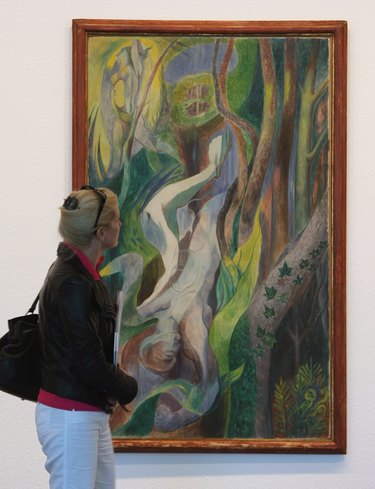
Understanding the concepts behind the forces of abstract and realist art will help you to better understand what constitutes abstract realism. Abstract art is art that doesn't have a definable focus. It is art that exists through patterns, colors, texture and line without the need for an external motivation. Realistic art consists of art that aims to replicate nature. When these two elements combine to create an abstract impression of real life, you get abstract realism.
Abstract Realism
Video of the Day
Abstract realism is difficult to explain because of the infusion of two distinct styles of art: abstract and realistic. Abstract does not attempt to depict real objects, as it is concerned only with the colors, lines, shapes and rhythms that create the artwork. In a sense, abstract art is art without a concrete, physical construct to work from. Realistic art aims to create realistic interpretations of real objects. When you combine these two concepts, you get a new style of art that attempts to depict the emotions behind a particular real-life object.
Video of the Day
Realist Paintings
With the advent of photography, it was no longer necessary to create a realistic image of a mountain, person, object or place. Realism was replaced with the need for artists to find a new way to describe the world around them. Instead of painting the surface of objects, artists began looking for ways to skew realistic imagery to depict real objects in creative and artistic ways. However, in the 20th century, realism has made some advances as an art form.
Techniques
The goal of abstract realism involves using abstract painting techniques to slightly distort a real object. Artists take an image and distort it through impressionist, surrealistic and expressionist techniques to make the painting recognizable but somewhat blurred and distorted. You might think of the technique of abstract art as looking at an object through the bottom of a clear glass. The image is still there, but it has been misshaped by the refractions from the glass.
Artists
Jackson Pollock, Franz Kline and William de Kooning are some of the leaders of the abstract realism movement. Pollock worked in several forms of media, including print and film. He also created a drip technique in which paint was dripped onto a canvas. Kline used wide, strong strokes of paint across an entire canvas and created extremely abstract paintings. Both of these artists took an originally recognizable object and distorted it to the point it was no longer recognizable. De Kooning was an abstract realist in the more literal sense. In his painting "Woman and a Bicycle," he paints an image of a woman on a bicycle, then uses strong, violent brushstrokes to paint over the woman in a way that leaves the woman still present in the painting, but muted.